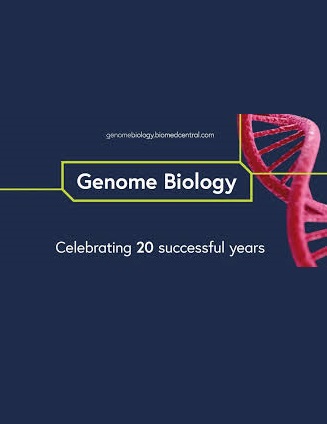A refined analysis of Neanderthal-introgressed sequences in modern humans with a complete reference genome
IF 10.1
1区 生物学
Q1 BIOTECHNOLOGY & APPLIED MICROBIOLOGY
引用次数: 0
Abstract
Leveraging long-read sequencing technologies, the first complete human reference genome, T2T-CHM13, corrects assembly errors in previous references and resolves the remaining 8% of the genome. While studies on archaic admixture in modern humans have so far relied on the GRCh37 reference due to the availability of archaic genome data, the impact of T2T-CHM13 in this field remains unexplored. We remap the sequencing reads of the high-quality Altai Neanderthal and Denisovan genomes onto GRCh38 and T2T-CHM13. Compared to GRCh37, we find that T2T-CHM13 significantly improves read mapping quality in archaic samples. We then apply IBDmix to identify Neanderthal-introgressed sequences in 2504 individuals from 26 geographically diverse populations using different reference genomes. We observe that commonly used pre-phasing filtering strategies in public datasets substantially influence archaic ancestry determination, underscoring the need for careful filter selection. Our analysis identifies approximately 51 Mb of Neanderthal sequences unique to T2T-CHM13, predominantly in genomic regions where GRCh38 and T2T-CHM13 assemblies diverge. Additionally, we uncover novel instances of population-specific archaic introgression in diverse populations, spanning genes involved in metabolism, olfaction, and ion-channel function. Finally, to facilitate the exploration of archaic alleles and adaptive signals in human genomics and evolutionary research, we integrate these introgressed sequences and adaptive signals across all reference genomes into a visualization database, ASH ( www.arcseqhub.com ). Our study enhances the detection of archaic variations in modern humans, highlights the importance of utilizing the T2T-CHM13 reference, and provides novel insights into the functional consequences of archaic hominin admixture.现代人中尼安德特人基因渗入序列的精细分析,具有完整的参考基因组
利用长读数测序技术,第一个完整的人类参考基因组 T2T-CHM13 纠正了以前参考文献中的组装错误,并解决了剩余 8% 的基因组问题。由于存在古人类基因组数据,有关现代人中古人类混杂的研究迄今为止一直依赖于 GRCh37 参考文献,而 T2T-CHM13 在这一领域的影响仍有待探索。我们将高质量阿尔泰尼安德特人和丹尼索瓦人基因组的测序读数重新映射到 GRCh38 和 T2T-CHM13 上。与 GRCh37 相比,我们发现 T2T-CHM13 显著提高了古老样本的读数映射质量。然后,我们利用 IBDmix,使用不同的参考基因组,在来自 26 个不同地域人群的 2504 个个体中识别尼安德特人的入侵序列。我们发现,公共数据集中常用的预分期过滤策略会严重影响古人类祖先的确定,因此需要谨慎选择过滤策略。我们的分析发现了约 51 Mb 的尼安德特人序列,这些序列是 T2T-CHM13 所独有的,主要分布在 GRCh38 和 T2T-CHM13 组合出现分歧的基因组区域。此外,我们还在不同种群中发现了新的种群特异性古基因导入实例,涉及新陈代谢、嗅觉和离子通道功能的基因。最后,为了便于在人类基因组学和进化研究中探索古老等位基因和适应性信号,我们将所有参考基因组中的这些引入序列和适应性信号整合到一个可视化数据库 ASH ( www.arcseqhub.com ) 中。我们的研究增强了对现代人类古老变异的检测,强调了利用 T2T-CHM13 参考文献的重要性,并对古人类混杂的功能性后果提供了新的见解。
本文章由计算机程序翻译,如有差异,请以英文原文为准。
求助全文
约1分钟内获得全文
求助全文
来源期刊

Genome Biology
Biochemistry, Genetics and Molecular Biology-Genetics
CiteScore
21.00
自引率
3.30%
发文量
241
审稿时长
2 months
期刊介绍:
Genome Biology stands as a premier platform for exceptional research across all domains of biology and biomedicine, explored through a genomic and post-genomic lens.
With an impressive impact factor of 12.3 (2022),* the journal secures its position as the 3rd-ranked research journal in the Genetics and Heredity category and the 2nd-ranked research journal in the Biotechnology and Applied Microbiology category by Thomson Reuters. Notably, Genome Biology holds the distinction of being the highest-ranked open-access journal in this category.
Our dedicated team of highly trained in-house Editors collaborates closely with our esteemed Editorial Board of international experts, ensuring the journal remains on the forefront of scientific advances and community standards. Regular engagement with researchers at conferences and institute visits underscores our commitment to staying abreast of the latest developments in the field.
 求助内容:
求助内容: 应助结果提醒方式:
应助结果提醒方式:


